Terceira (Portuguese pronunciation: [tɨɾˈsɐjɾɐ]) is a volcanic island in the Azores archipelago, about a third of the way across the North Atlantic Ocean at a similar latitude to Portugal's capital Lisbon, and the island group is owned by Portugal. It is one of the larger islands of the archipelago, with a population of 53,311 inhabitants in an area of approximately 396.75 km².
Terceira is the location of the Azores' oldest city, Angra do Heroísmo, the historical capital of the archipelago and UNESCO World Heritage Site; the seat of the judicial system (Supreme Court); and the main Air Force base, Base Aérea nº 4 at Lajes, with a United States Air Force detachment.
Terceira island has two main sea ports, one at Angra do Heroísmo and the other at Praia da Vitória, and a commercial airport integrated with the flight operations at Base Aérea nº 4. The Portuguese bullfight is popular on t...Read more
Terceira (Portuguese pronunciation: [tɨɾˈsɐjɾɐ]) is a volcanic island in the Azores archipelago, about a third of the way across the North Atlantic Ocean at a similar latitude to Portugal's capital Lisbon, and the island group is owned by Portugal. It is one of the larger islands of the archipelago, with a population of 53,311 inhabitants in an area of approximately 396.75 km².
Terceira is the location of the Azores' oldest city, Angra do Heroísmo, the historical capital of the archipelago and UNESCO World Heritage Site; the seat of the judicial system (Supreme Court); and the main Air Force base, Base Aérea nº 4 at Lajes, with a United States Air Force detachment.
Terceira island has two main sea ports, one at Angra do Heroísmo and the other at Praia da Vitória, and a commercial airport integrated with the flight operations at Base Aérea nº 4. The Portuguese bullfight is popular on the island, coming in two variations: the traditional equestrian bullfight (in the ring) and the popular "touradas à corda" that occur in the streets.
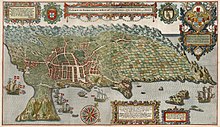 Terceira in 1595 by Jan Huyghen van Linschoten, "A cidade de Angra na ilha de Iesu xpō da Tercera que esta em 39. graos"
Terceira in 1595 by Jan Huyghen van Linschoten, "A cidade de Angra na ilha de Iesu xpō da Tercera que esta em 39. graos"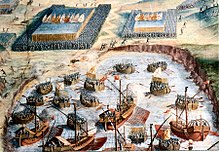 Troops disembarking during the Battle of Terceira; mural in the Monastery of São Lorenzo de El Escorial
Troops disembarking during the Battle of Terceira; mural in the Monastery of São Lorenzo de El EscorialHistorically, there has been uncertainty in the date and the discoverer associated with the islands of the Azores. Nautical charts before the "official" discovery identified islands in the Atlantic Ocean as far back as 1325, when a chart by Angelino Dalorto identified "Bracile" west of Ireland, and later one by Angelino Dulcert which identifies the Canaries, and Madeira, along with mysterious islands denominated as "Capraria" (which some historians suggest were São Miguel and Santa Maria). Legends also persisted of Atlantis, Sete Cidades (Kingdoms of the Seven Cities), the Terras of São Brandão, the Ilhas Aofortunadas (The Fortunate Islands), the Ilha da Brasil (the Island of Brasil), Antília, the Ilhas Azuis (Blue Islands), and the Terra dos Bacalhaus (Land of Codfish), and charts appeared between 1351 and 1439 of several groupings of islands with various names. The first association between the modern island of Terceira and these stories, was that of the island of Brasil; it first appears as Insula de Brasil in the Venetian map of Andrea Bianco (1436), attached to one of the larger islands of a group of islands in the Atlantic.[citation needed]
In 1439, the first official discovery document appeared, attributing the discovery of the Formigas to Gonçalo Velho Cabral.[1] There is an indication that Terceira may have been discovered by Vicente de Lagos, Velho Cabral's pilot, on 1 January 1445:[2] the first documents after this period started appearing with a third island in the Azorean archipelago, referred to as the Ilha de Jesus Cristo (Island of Jesus Christ), and later, Ilha de Jesus Cristo da Terceira. Gaspar Frutuoso, a chronicler and humanist, would later rationalize about the island's first name, noting that:
it was discovered on the first day of January, traditionally the feast day of the name of Jesus; it was discovered by a captain in the Order of Christ; it was discovered on a Thursday or Friday, on Corpo de Deus (Body of Christ); or because it was part of the dioceses of Angra, through the invocation of San Salvador (although this implies that a dioceses existed prior to its discovery).Regardless, it was only a temporary name, as the colloquial Terceira (meaning "third" in Portuguese, as in "the third island" or "third to be discovered") was used more often to describe the island.
The colonization of the island began by decree of Infante D. Henrique (dated 21 March 1450), and placed the island in the administrative hands of the Fleming Jácome de Bruges. Its first settler was Fernão d'Ulmo, a Fleming or Frenchman, who later abandoned his plot, for unknown reasons.[2] Bruges, although a Flemish nobleman, continued to bring families and settlers from Flanders, and northern Portuguese adventurers (João Coelho, from Guimarães; João da Ponte, from Aveiro; João Bernardes, from Lagos; João Leonarde, from Vieira; and Gonçalo Anes da Fonseca, from Porto),[2] as well as animals and provisions, disembarking in the area of Porto Judeu or Pesqueiro dos Meninos, near Vila de São Sebastião (depending on sources). Frutuoso also affirmed that:
...that ancient settlers of the island of Terceira, that were the first to settle in a band to the north, where they call Quatro Ribeiras, where now the parish of Santa Beatriz is located, and where the first church existed on the island, but were few settlers remained due to difficult access and bad port.
The first settlement occurred in Quatro Ribeiras, in the locality of Portalegre,[3] where a small chapel was raised for the invocation of Santa Ana. Bruges made return trips to Flanders for new settlers to his colony. On one of his trips to Madeira, he conscripted Diogo de Teive and assigned him as his lieutenant and overseer for the island of Terceira. A few years later, Bruges moved his residence to Praia, began construction on the Matriz Church in 1456, and administered the Captaincy of the island from this location (around 1460), until he mysteriously disappeared in 1474, on another of his trips between the colony and the continent.[2] Following his disappearance, the Infanta D. Beatriz, in the name of her son the Infante D. Diogo (who inherited the islands of Terceira and Graciosa following the death D. Fernando, the adopted son of the Infante D. Henrique) divided the island of Terceira into two captaincies: Angra (which was given to João Vaz Corte Real) and Praia (which was given to Álvaro Martins Homem).[2][4] Apart from the Portuguese and Flemish settlers, colonists from Madeira, many slaves from Africa, new Christians and Jews populated the island at this time, developing new commercial ventures including wheat (exported during the 15th century throughout the empire), sugar-cane, woad (for the dye industry) and woods (principally for the naval construction industries). This development would continue until the end of the 19th century, with the introduction of new products, including tea, tobacco and pineapple.
During the Portuguese succession crisis of 1580, the Azores was the only portion of the Portuguese overseas empire to resist the Spanish until the summer of 1583. Philip II of Spain had offered an amnesty if the Azores surrender, but his messenger met with a very hostile reception at Angra do Heroísmo (escaping to São Miguel, which had presented its allegiance to the King of Spain). Following the Battle of Ponta Delgada, where Don Álvaro de Bazán, 1st Marquis of Santa Cruz defeated the Anglo-French supporters of D. António (the pretender to the Portuguese throne) off the coast of São Miguel, the Marquis concentrated his forces at a less defended beach 10 kilometres (6.2 mi) from Angra do Heroísmo. With a fleet to ninety-six ships and 9,500 men (as well as a garrison of 2,000 on Sao Miguel) the Marquis was able to defeat the forces of D. António after one day's fighting. Although French and English soldiers on the island were allowed to retire unharmed, D. Antonio and a handful of his supporters were lucky to escape with their lives.
One year later, the conquest of the Azores was complete after the island of Terceira was reconciled, followed by the seizure of the island of Faial.
An English expedition fleet under the Earl of Cumberland in 1589, as part of the Azores Voyage of 1589 into Angra Bay, attacked several harbouring Spanish and Portuguese ships and was able to sink or capture five.
 Print of the Angra op Tercera, showing the city of Angra and portions of the island, Jacob van Meurs, 1671
Print of the Angra op Tercera, showing the city of Angra and portions of the island, Jacob van Meurs, 1671With the acclamation of John IV of Portugal, the Azores applauded the restoration of independence from the Iberian Union. This was not lost on the Spanish settlers in Angra do Heroísmo, who had become a privileged class during the Union, and which made it difficult for them to remain after 1640, when Portuguese sovereignty was restored.
In 1766, the reorganization of system of Captaincies was undertaken, resulting in one Captain-General, with his seat in Angra do Heroísmo for the Azores.
In 1810, a number of journalists and others considered to favor the French, including the industrialist Jácome Ratton, were exiled to the island for a period.
Political tension rose in the 1820s between constitutionalists or Liberals, (supporters of the constitutional monarchy installed by King John VI of Portugal) and those who supported absolute monarchy. Having embraced the cause of constitutionalism, the local Terceirenses established a Junta Provisória in the name of Queen Maria II of Portugal in 1828. Hostilities broke out at the Battle of Praia da Vitória in 1829. In a decree, issued on 15 March 1830, Angra was named as Portuguese capital by the Terceirenses constitutional forces,[5] who protected and supported exiled Liberals who supported the rights of Queen Maria II of Portugal, whose rights were usurped by the Miguelistas (supporters of the absolute monarchy of Miguel I). In 1832, Pedro I (former King and regent of Queen Maria) arrived in the Azores to form a government-in-opposition to the absolutionist regime in Lisbon, presided by the Marques of Palmela, and supported by Azoreans Mouzinho da Silveira and Almeida Garrett that developed many important reforms.
On 24 August 2001, Terceira made the news as Air Transat Flight 236 managed to land at Lajes Field after running out of fuel in mid-air.
On 16 March 2003, President of the United States George W. Bush, UK Prime Minister Tony Blair, Spanish Prime Minister José María Aznar and Prime Minister of Portugal José Manuel Barroso met on Terceira to discuss the Invasion of Iraq, which began four days later, on 20 March.
On 15 January 2016, then Tropical Storm Alex made an unprecedented landfall on the island with sustained winds reaching 65 miles per hour. This landfall was unprecedented due to the time of year it occurred, which was mid-January. Alex is one of four known tropical cyclones to make landfall on the Island of Terceira, with the others being an unnamed hurricane in 1889, another unnamed hurricane in 1940, and Hurricane Carrie in 1957.



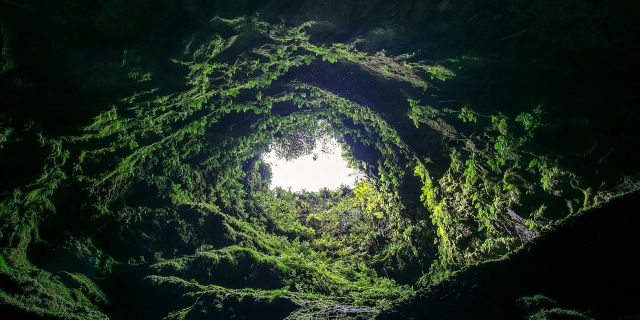




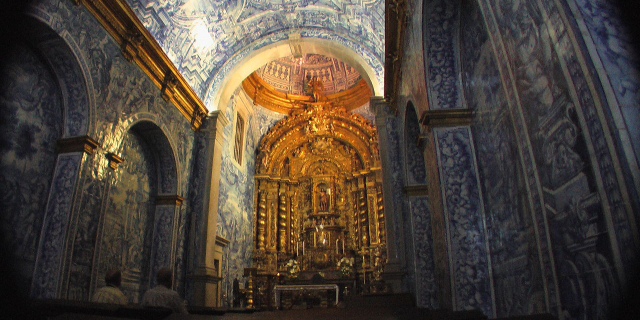

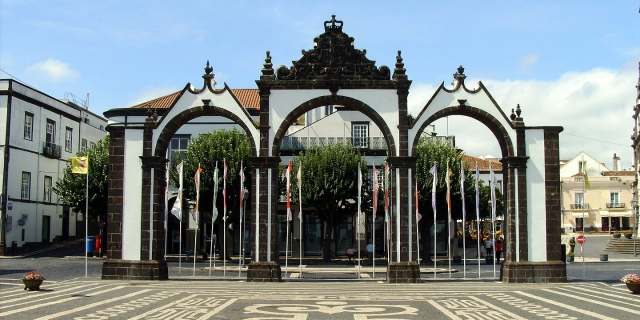




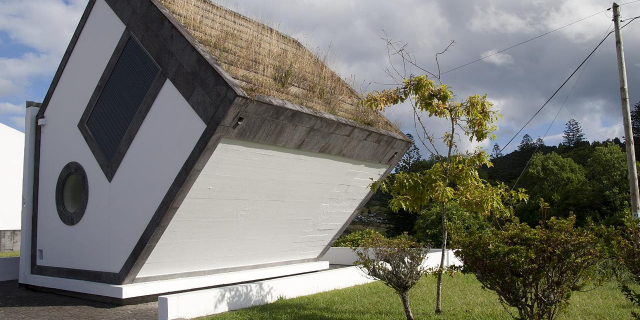


Add new comment